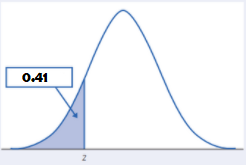Use Table A to find the value z of a standard Normal variable that satisfies each of the following conditions. Use the value of z from Table A that comes closest to satisfying the condition. In each case, sketch a standard Normal curve with your value of z marked on the axis. (a) Find the point z with 66% of the observations falling below it. Enter your answer rounded to two decimal places. z= (b) Find the point z with 24% of the observations falling above it. Enter your answer rounded to two decimal places. z=
Continuous Probability Distributions
Probability distributions are of two types, which are continuous probability distributions and discrete probability distributions. A continuous probability distribution contains an infinite number of values. For example, if time is infinite: you could count from 0 to a trillion seconds, billion seconds, so on indefinitely. A discrete probability distribution consists of only a countable set of possible values.
Normal Distribution
Suppose we had to design a bathroom weighing scale, how would we decide what should be the range of the weighing machine? Would we take the highest recorded human weight in history and use that as the upper limit for our weighing scale? This may not be a great idea as the sensitivity of the scale would get reduced if the range is too large. At the same time, if we keep the upper limit too low, it may not be usable for a large percentage of the population!


a)
The point z with 66% of the observations falling below it is obtained as below:
The value of z is obtained as follows:
The value of z is obtained from Excel using "=NORMSINV(probability)".
Output obtained using Excel is given below:

From the output, the z value is 0.41.
Thus, the point z with 66% of the observations falling below it is 0.41.

Trending now
This is a popular solution!
Step by step
Solved in 2 steps with 4 images









